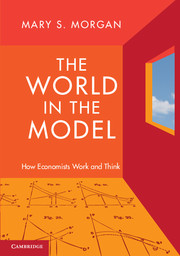Book contents
- Frontmatter
- Contents
- Figures, Tables, and Boxes
- Preface
- 1 Modelling as a Method of Enquiry
- 2 Model-Making: New Recipes, Ingredients, and Integration
- 3 Imagining and Imaging: Creating a New Model World
- 4 Character Making: Ideal Types, Idealization, and the Art of Caricature
- 5 Metaphors and Analogies: Choosing the World of the Model
- 6 Questions and Stories: Capturing the Heart of Matters
- 7 Model Experiments?
- 8 Simulation: Bringing a Microscope into Economics
- 9 Model Situations, Typical Cases, and Exemplary Narratives
- 10 From the World in the Model to the Model in the World
- Index
- Plate Section
- References
1 - Modelling as a Method of Enquiry
Published online by Cambridge University Press: 05 November 2012
- Frontmatter
- Contents
- Figures, Tables, and Boxes
- Preface
- 1 Modelling as a Method of Enquiry
- 2 Model-Making: New Recipes, Ingredients, and Integration
- 3 Imagining and Imaging: Creating a New Model World
- 4 Character Making: Ideal Types, Idealization, and the Art of Caricature
- 5 Metaphors and Analogies: Choosing the World of the Model
- 6 Questions and Stories: Capturing the Heart of Matters
- 7 Model Experiments?
- 8 Simulation: Bringing a Microscope into Economics
- 9 Model Situations, Typical Cases, and Exemplary Narratives
- 10 From the World in the Model to the Model in the World
- Index
- Plate Section
- References
Summary
From Laws to Models, From Words to Objects
Two hundred years ago, political economy was overwhelmingly a verbal science, with questions,concepts, and a mode of reasoning all dependent on words. As a science, classicalpolitical economy of the eighteenth and early nineteenth centuries began with individuals, theorizedtheir relations, and posited a few general laws that operated at a community level. One of the fewlaws that was expressed in mathematics was proposed by the Rev’d Thomas Robert Malthus, whoclaimed that the growth of population, driven by passions, increased in a way that would inevitablyoutstrip the more pedestrian growth of food supplies. So, he argued, there must also be checks atwork in the world: the numbers of people were kept in check either through the vices of disease,famine, and war, or by virtue of celibacy or delayed marriage. While such laws might indeed have aniron grip on economic life, it was not thought easy to perceive these laws at work amongst thecomplicated changing events of everyday life. This created difficulties for the artof political economy, namely fashioning policy in line with an understanding of those scientificprinciples of political economy.
Economics is now a very different kind of activity. From the late nineteenth century, economicsgradually became a more technocratic, tool-based, science, using mathematics and statistics embeddedin various kinds of analytical techniques. By the late twentieth century, economics had becomeheavily dependent on a set of reasoning tools that economists now call ‘models’: smallmathematical, statistical, graphical, diagrammatic, and even physical objects that can bemanipulated in various different ways. Today, in the twenty-first century, if we go to an economicsseminar, or read a learned scientific paper in that field, we find that economists write down someequations or maybe draw a diagram, and use those to develop solutions to their theoreticalconundrums or to answer questions about the economic world. These manipulable objects are thepractical starting point in economic research work: they are used for theorizing, providinghypotheses and designing laboratory experiments, they are an essential input into simulations, andthey form the basis for much statistical work. Economics teaching is similarly bounded: studentslearn by working through a set of models: some portraying decisions by individuals and companies,others representing the behaviour of the whole economy, and for every level in between.
Information
- Type
- Chapter
- Information
- The World in the ModelHow Economists Work and Think, pp. 1 - 43Publisher: Cambridge University PressPrint publication year: 2012
References
Accessibility standard: Unknown
Why this information is here
This section outlines the accessibility features of this content - including support for screen readers, full keyboard navigation and high-contrast display options. This may not be relevant for you.Accessibility Information
- 1
- Cited by
